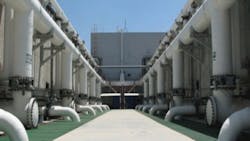NanoH2O to Build Reverse Osmosis Membrane Manufacturing Facility in China
NanoH2O, Inc., a Los Angeles-based manufacturer of reverse osmosis (RO) membranes for seawater desalination, announced yesterday plans to build a manufacturing facility in Liyang, China, a city in the Yangtze River Delta 250 kilometers west of Shanghai.
The 10,000 square meter facility will be the company's second fully integrated manufacturing plant, following the first located in Los Angeles, California. The China facility comes at a total investment of $45 million and is expected to be operational by the end of 2014.
"Developing new sources of affordable, clean water is a priority for China's ongoing economic development," said Jianghua Su, Mayor of Liyang. "Liyang is excited to welcome NanoH2O and its leading desalination membrane technology to China, adding to Liyang's growing roster of multi-national industrial and cleantech corporations looking to expand global operations and commercial efforts."
China, which represents one-fifth of the world's population but just 6% of the global fresh water supply, plans to increase its seawater reverse osmosis desalination capacity three-fold by 2015.
The overall membrane market in China is estimated to grow more than 20% per year over the next 10 years. The Chinese government's current five-year plan also calls for 70% of equipment used in desalination plants to be produced domestically.
Marketed under the QuantumFlux brand, NanoH2O's thin-film nanocomposite (TFN) membrane represents the first significant RO membrane technology innovation in 25 years. By incorporating benign nanomaterials into its patented thin-film layer, NanoH2O has improved key performance characteristics by controlling membrane structure. QuantumFlux RO membranes have demonstrated a 50-100% increase in permeability when compared to traditional thin-film RO membranes.
This increased permeability means less pressure is required to produce fresh water through the membrane, thus lowering a desalination plant's energy costs. Alternatively, at the same operating pressure, the increased permeability leads to an increase in the amount of fresh water produced.
"Just two years after our commercial entry into the RO membrane and desalination markets, the opening of this second facility marks a major expansion for our company that will allow us to support a rapidly growing international market," said Jeff Green, Chief Executive Officer and Chairman of NanoH2O. "The Liyang plant is the first RO membrane manufacturing facility in Chinato utilize advanced nanotechnology.”
About the Author
IW Staff
Find contact information for the IndustryWeek staff: Contact IndustryWeek
